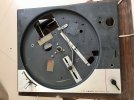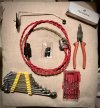All the best Steve..looking forward to this, Am sure you have all the materials and information and hope you have fun !
On the plinth, please make sure the space under the central part of the top plate has a platform underneath and you screw the top plate that as well. that drains the vibrations very well.
Thanks Arj,
The mounting was one thing that left me mildly puzzled as how the screws would be fitted into the wood underneath, then I saw I think it was Ropie's plinth plans where he says to screw the pan to the wood layer underneath. There are three holes available at 12 o'clock, 6 o'clock and 3 o'clock in the pan so should be easy to do also should be easy to drill a hole through in another area if required. One question could you clarify or point me to reasoning as to why most Lenco's are only in high mass plinths? Cos to me it seems to be this way cos Nantais advocated this approach while Loricraft advocated squash balls and both became popular but I can't reason out why squash balls wouldn't work on a Lenco as it does for the Garrard. High mass works yes, but why only this and not squash balls? The high mass adds 'weight' to the presentation because the Lenco motor is not as powerful as the Garrard's and the high mass added weight helps matters? It's the only thing I can think of. I'm trying to search online to find some answers. I have a funky plinth idea that will drain the top plate vibration but does not involve so much wood, the top plate screwed onto vertical independent columns of layered wood layers and these columns stand in an acrylic see through enclosure filled with beach sand, which contacts the wood columns and forms a bigger vibration drain sink. Or a single layer of wood resting on sand. Facing outwards inside the acrylic will be seashells I've collected. I'm tired of the bog standard wood rectangular plinths.
Also what lubricating oil do you use for the platter bearing? People seem to use all kinds! Will also need some grease for the motor bearing, will be barely a dab, wondering what kind to buy and where...
Yesterday was reading day, figured out how to lube and service the motor and other bits and bobs about how the Lenco is built and why. Today I took off the springs and ran the turntable, it turns. First time the idler wheel seemed to have forgotten its job and just sat there, I had to spin the platter with my hand and then it caught. After that it spins decently. Motor makes noise though.
Things to do:
1. Buy a soldering iron and solder the spark suppressor capacitor. It still looks good so hopefully won't have to buy a new one.
2. Get a main cable from Viren and wire the motor up with it like I did for the Garrard.
3. Buy an idler tension spring, the current one is way too stretched out. Apparently as per lencoheaven, its the motor springs that cause the motor cone and the idler wheel to connect strongly and the idler spring just brings the idler in contact but still its just too beat up to use I have currently stretched it and looped it around the post a quarter of its length shorter to increase tension and have the idler wheel move for now.
4. Service the motor. The platter bearing runs super smooth from a lube with 3-in-1 oil when I first got it, no noise. Will top up and stick to 3 in 1 oil for now.
Roughly checked the mounting distance for the SME. It seems to fit only at the 12 o 'clock position directly above the spindle, pointing directly to the spindle. Works better for me since the cartridge end will be easier to reach with the turntable placed with switches facing the user as intended, which I like.
Mat is serviceable as of now, but a bit on the hard side, later on will consider a new one.



